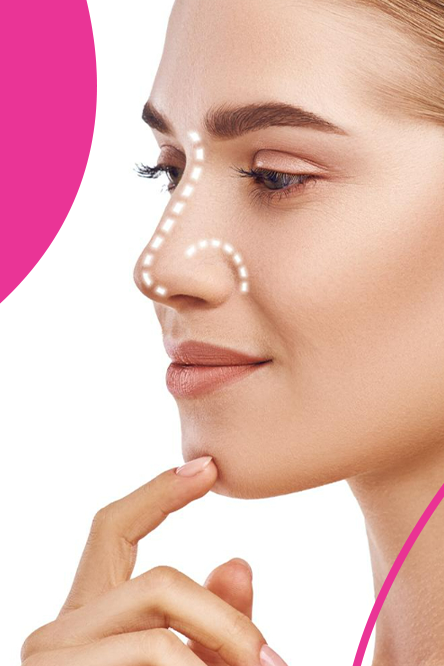

Rhinoplasty, also known as a “nose job,” is a surgical procedure that is used to change the shape and size of the nose. It can be used to correct a variety of issues, including a crooked nose, a hooked nose, a large nose, or a nose that is out of proportion with the rest of the face.

Bellaroma is a board-certified plastic surgery hospital in United Arab Emirates. We are three-time winner of Best of Plastic Surgery Award in the cosmetic surgeons category.
Our team is led by board-certified rhinoplasty surgeons with extensive experience in performing successful procedures.
Treating Nose Bridge:
When addressing the nose bridge, the surgical intervention involves the removal of the hump forming bone or cartilage. Following this, the remaining fragments of the nasal structure are meticulously connected or conjoined to refine and narrow down the nose.
Nose Width Adjustment:
In cases where nose width needs adjustment, a strategic approach is taken to predominantly narrow it down. This is achieved by delicately breaking the bone and adjusting its position for a more proportionate appearance.
Nose Tip Treatment:
For issues related to the nose tip, both closed and open Rhinoplasty techniques are employed. This process entails the careful removal or reshaping of the cartilage supporting the tips, ensuring a harmonious alignment and aesthetic enhancement.
Augmentation Rhinoplasty:
For individuals seeking to alter the contour of a flat bridge or tip, Augmentation Rhinoplasty comes into play. This involves modifying the bone, cartilage, or incorporating an implant. The source of bone or cartilage may be derived from the nose itself or other areas such as the rib, hip, or ear, resulting in a refined and augmented nasal profile.
Septum Rhinoplasty:
In cases where the nose is flattened due to injury or trauma, resulting in a buckled septum and severe breathing issues, Septum Rhinoplasty is the solution. This corrective procedure addresses the flattened septum through a single surgery, although additional surgeries may be necessary in some instances.
Rest: Allow yourself ample time to rest in the initial days following surgery. Avoid strenuous activities and get plenty of sleep to aid the healing process.
Elevate Your Head: Keep your head elevated, even while sleeping, to minimize swelling. This helps promote better blood circulation and reduces discomfort.
Follow Medication Instructions: Take prescribed medications as directed, including pain relievers and antibiotics. This will manage pain and prevent infection.
Cold Compresses: Apply cold compresses to the swollen areas for the first 48 hours. This helps reduce swelling and minimizes bruising.
Arnica Montana: Consider using Arnica Montana supplements or cream as recommended by your surgeon to further minimize bruising and swelling.
Gentle Cleaning: Follow your surgeon’s instructions for cleaning the incision sites and the surrounding areas gently. Use a saline solution or the provided cleaning solution.
Avoiding Pressure: Be cautious not to apply pressure to the nose, and refrain from blowing your nose forcefully during the initial days.
Nasal Splints and Dressings: If your surgeon used nasal splints or dressings, follow their guidelines for their care and removal.
Hydration: Stay well-hydrated to support the healing process.
Soft Diet: Stick to a soft diet in the first few days to avoid excessive jaw movement.
Follow-Up Appointments: Attend all scheduled follow-up appointments with your surgeon to monitor your progress and address any concerns.
Gradual Resumption of Activities: Ease back into your regular activities, avoiding strenuous exercise for the period advised by your surgeon.
Sun Protection: Protect your nose from the sun using sunscreen and, if possible, a hat to prevent pigmentation changes.


The recovery period varies for each individual, but generally, patients can expect noticeable improvement within the first two weeks. While most swelling and bruising resolve in the first month, the complete healing process may take several months. Your surgeon will provide a personalized timeline during your follow-up appointments.
Like any surgical procedure, rhinoplasty carries inherent risks. These can include infection, bleeding, adverse reactions to anesthesia, or unsatisfactory aesthetic results. Your surgeon will thoroughly discuss potential risks during the pre-operative consultation, and adherence to post-operative care instructions minimizes these risks.
Yes, many patients opt to combine rhinoplasty with other cosmetic procedures such as chin augmentation or eyelid surgery for a more comprehensive facial enhancement. Combining procedures can reduce overall recovery time and provide a harmonious aesthetic balance. Your surgeon will advise you on the feasibility of combining specific procedures based on your individual health and goals.
Patients may experience some discomfort in the days following rhinoplasty, but pain is usually well-managed with prescribed medications. Most individuals find that any initial discomfort diminishes quickly, and the use of cold compresses can further alleviate swelling and pain. Following the recommended pain management plan is essential for a more comfortable recovery.
Selecting a skilled and experienced surgeon is crucial for achieving the desired results. Research potential surgeons, review their credentials, and look for board certification in plastic or facial plastic surgery. Explore before-and-after photos, read patient testimonials, and schedule consultations to discuss your goals and ask questions. A qualified surgeon will prioritize your safety, understand your aesthetic vision, and provide a customized treatment plan.

UAE also embodies the essence of self compassion and self care that is part of Bellaroma message to the world.